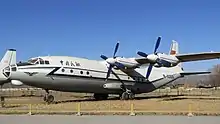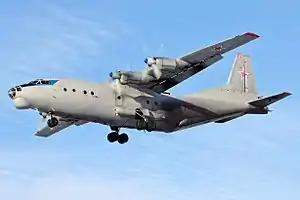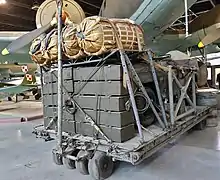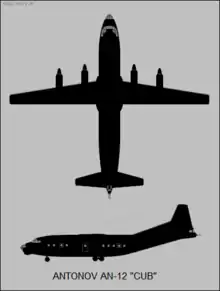Antonov An-12
The Antonov An-12 (Russian: Антонов Ан-12; NATO reporting name: Cub) is a four-engined turboprop transport aircraft designed in the Soviet Union. It is the military version of the Antonov An-10 and has many variants. For more than three decades the An-12 was the standard medium-range cargo and paratroop transport aircraft of the Soviet air forces. A total of 1,248 were eventually built.[2]

| An-12 | |
|---|---|
 | |
| An-12 of the Russian Air Force | |
| Role | Civil and military transport aircraft |
| Manufacturer | Antonov |
| First flight | 16 December[1] 1957 |
| Introduction | 1959 |
| Status | Active service with various airlines (especially cargo) and air forces |
| Primary users | Soviet Air Force Aeroflot PLA Air Force |
| Produced | 1957–1973 |
| Number built | 1,248 |
| Developed from | Antonov An-10 |
| Variants | Shaanxi Y-8 |
Design and development
Developed from the Antonov An-8, the An-12 was a military version of the An-10 passenger transport. The first prototype An-12 flew in December 1957 and entered Soviet military service in 1959. Initially, the aircraft was produced at the State Aviation Factory in Irkutsk. From 1962, production was transferred to Tashkent, where 830 were built. Later, production moved to Voronezh and Kazan.[2]
In military use, the An-12 has capacity for up to 100 fully equipped paratroopers or 20,000 kg (44,090 lb) of cargo, which is loaded through the rear loading ramp/door.[2]
In terms of configuration, size, and capability, the aircraft is similar to the United States-built Lockheed C-130 Hercules. Soviet military and former-Soviet An-12s have a defensive tail gun turret.
Chinese production
In the 1960s, China purchased several An-12 aircraft from the Soviet Union, along with a license to assemble the aircraft locally. Due to the Sino-Soviet split, the Soviet Union withdrew its technical assistance. The Xi'an Aircraft Company and Xi'an Aircraft Design Institute reverse-engineered the An-12 for local production, and the first flight of a Chinese-assembled An-12 was delayed until 1974 after USSR ceased production in 1973.[3]
In 1981, the Chinese version of the An-12, designated Y-8, finally entered production. Since then, the Y-8 has become one of China's most popular military and civilian transport/cargo aircraft, with many variants produced and exported. A Tu-16/H-6 bomber navigator cockpit design was chosen for the Y-8 instead of the original An-12 shorter navigator cockpit design, as the H-6 bomber had been in serial production for some time. Although the An-12 is no longer in use either in Russia or in Ukraine, the Y-8 is upgraded and produced in China. The latest Y8-F600 is a joint venture between the Shaanxi Aircraft Company, Antonov Aeronautical Scientific Technical Complex (ASTC), and Pratt & Whitney Canada. The Y8-F600 has a redesigned fuselage, western avionics, PW150B turboprop engines with an R-408 propeller system, and a two-crew glass cockpit.[5]
Operational history

Soviet Air Forces
The Aircraft first took flight in 1957 and was produced in the USSR until 1973. It was used in a variety of roles from search and rescue operations to equipment transportation. Its most significant use was seen during the Soviet-Afghan War. Among Soviet Soldiers, it was infamously known that the plane would take off from Afghanistan to Tashkent with "Cargo 200" or coffins with the bodies of deceased soldiers. To this regard the aircraft was nicknamed "Black Tulip" (Russian: «Чёрный тюльпан»).[6]
Variants
In addition to its basic cargo transport role, the An-12 was adapted as a platform for a wide variety of specialist tasks and some 30 different variants were produced. Upgrades included increased take-off weights and additional fuel capacity. The upgraded variant An-12BP became the standard tactical transport of the Soviet and other air forces.[2] In 2019, it was announced at the military "Army-2019" Forum that Russia started working on an armed ground-attack and close air support variant of the An-12, similar to the AC-130.[7] In 2021, it was announced that the gunship will not be based on the An-12 after all, as it did not meet the requirements for a "flying gunner."[8]
Operators
Currently the An-12 is popular with cargo operators, especially those in the CIS, Africa and the Indian subcontinent.[9]
Civil operators


On 12 January 2009, the United Arab Emirates (UAE) issued a temporary ban of the An-12 from flying over their airspace following runway incursions at Sharjah International Airport and the GCAA has advised operators to stop using the aircraft.[10][11] The ban was made permanent in Feb 2010.[12]
Current
- Air Armenia
- Ruby Star Airways
- Air One (Mexico)
- ATRAN Cargo Airlines
- SAT Airlines
- Air People International
- Aerovis Airlines
- Antonov Airlines
- CAVOK Air
- Motor Sich Airlines
- Ukraine Air Alliance
- Volare Airlines
- SRX,[13] (still operated by Avialeasing)
Former
- Alada
- Balkan Bulgarian Airlines[14]
- Air Sofia
- CAAC Airlines;[15] see also Shaanxi Y8
- Darta
- Air Guinee
- Ghana Airways The sole An-12 was delivered in October 1961. Withdrawn from use in 1962 and returned to the Soviet Union in 1963.[16]
- Iraqi Airways[17]
- Interisland Airlines
- Avial Aviation
- United International Airlines
Current
- People's Air and Air Defence Force of Angola[20]
- Chadian Air Force[21]
- Ethiopian Air Force[22]
- Myanmar Air Force
- Nigerian Air Force – 12 An-12s in service
- Russian Air Force[24]
- Russian Naval Aviation[24]
- Sudanese Air Force[25]
- Uzbekistan Air and Air Defence Forces[26]
Former
- Algerian Air Force
- The Afghan Air Force operated 12 from 1981 through 2001. One of their An-12s which defected to Pakistan is preserved at PAF Museum, Karachi
- Bangladesh Air Force operated from 1973 to 1980s, now all retired
- Cote d'Ivoire Air Force
- Czech Air Force
- Czechoslovakian Air Force : Czechoslovakia's fleet numbering two was divided evenly between the Czech Republic and Slovak Republic upon split with Slovakia. All CzAF An-12s were phased out of active service in the 1990s.
- Egyptian Air Force - 22 acquired[27]
- The Indian Air Force inducted the first of these aircraft in 1961, when it raised No.44 Squadron "The Himalayan Geese". Six of these aircraft soon took part in airlifting army reinforcements to Ladakh during the Sino-Indian War of 1962. The An-12 was subsequently used to raise No.25 Squadron. The An-12s were also used as heavy bombers during the Indo-Pakistani War of 1971. All IAF An-12s were phased out of active service in the 1990s. One of them is preserved at the Indian Air Force Museum, Palam, New Delhi.
- Indonesian Air Force – Retired in 1970
- Iraqi Air Force – Retired in 2003
- Royal Jordanian Air Force
- Mongolian Air Force - Retired 12 An-12[29]
- Polish Air Force used two An-12B from 1966 until 1977 (crashed) and 1995[30]
- Slovak Air Force received one An-12BP registered 2209 in 1993. It was sold to Moldavia in 1999 and now serves with Angolan Air Force.[31]
- Yemeni Air Force
- The Soviet fleet was dispersed among many of the Soviet Union's successor states.
- Soviet Air Force
- Soviet Naval Aviation
- Syrian Air Force
- Tanzania Air Force Command
turkmenistan airforce
- Ukrainian Air Force
- Ukrainian Naval Aviation
- SFR Yugoslav Air Force
Specifications (An-12)

Data from Global Aircraft,[32] Airliners.net[33]
General characteristics
- Crew: 5 (two pilots, flight engineer, navigator, radio operator)
- Capacity: 20,000 kg (44,092 lb) payload / 60 paratroopers / 2x BMD-1 armoured vehicles
- Length: 33.1 m (108 ft 7 in)
- Wingspan: 38 m (124 ft 8 in)
- Height: 10.53 m (34 ft 7 in)
- Wing area: 121.7 m2 (1,310 sq ft)
- Empty weight: 28,000 kg (61,729 lb)
- Max takeoff weight: 61,000 kg (134,482 lb)
- Powerplant: 4 × Ivchenko AI-20L or AI-20M turboprop engines, 3,000 kW (4,000 shp) each equivalent
- Propellers: 4-bladed constant-speed reversible-pitch propellers
Performance
- Maximum speed: 660 km/h (410 mph, 360 kn)
- Cruise speed: 570 km/h (350 mph, 310 kn)
- Range: 5,700 km (3,500 mi, 3,100 nmi) with maximum fuel
- 3,600 km (2,200 mi; 1,900 nmi) with maximum payload
- Service ceiling: 10,200 m (33,500 ft)
- Rate of climb: 10.2 m/s (2,010 ft/min)
Armament
- Guns: 2× 23 mm (0.906 in) Nudelman-Rikhter NR-23 cannons in a tail turret (some aircraft)
See also
- Military transport aircraft
Related development
- Antonov An-22
- Shaanxi Y-8
Aircraft of comparable role, configuration, and era
- Lockheed C-130 Hercules
- Transall C.160
Related lists
- List of military aircraft of the Soviet Union and the CIS
References
Footnotes
- "Antonov official website". Archived from the original on 23 January 2018. Retrieved 15 August 2009.
{{cite web}}: CS1 maint: bot: original URL status unknown (link) - Allport, Dave (April 1996). "Military Transport Aircraft Directory (Part 2)". Air International. Vol. 50, no. 4. p. 237.
- "Y8 Turboprop Transport Aircraft". Sino Defence. Archived from the original on 27 March 2008.
- "Y8F600 aircraft". Shaanxi Aircraft Industry. Archived from the original on 21 May 2006.
- ""Чёрный тюльпан": почему советские солдаты в Афганистане так назвали самолёт АН-12". Русская Семёрка. Archived from the original on 8 April 2020. Retrieved 7 April 2020.
- "Источник: аналог американской летающей батареи AC-130 разрабатывается в России" [Source: Analogue of the American flying battery AC-130 is being developed in Russia]. TASS. 26 June 2019.
- Lavrov, Anton; Kretzul, Roman (12 January 2021). "Арсенал «Охотника»: транспортный самолет получит управляемые ракеты" [Arsenal "Hunter": transport aircraft will receive guided missiles]. Izvestia.
- Gordon, Yefim & Komissarov, Dmitry. Antonov An-12. Midland. Hinkley. 2007. ISBN 978-1-85780-255-9
- "GCAA issues temporary ban of Antonov An-12 from UAE airspace". Archived from the original on 1 February 2009. Retrieved 13 January 2009.
- "United Arab Emirates bans flights of Soviet-built An-12 aircraft". 12 January 2009. Archived from the original on 1 February 2009. Retrieved 13 January 2009.
- "UAE bans ANTONOV An-12 aircraft from its airspace". The Times of India. 19 February 2010. Archived from the original on 21 February 2010. Retrieved 19 February 2010.
- "SRX :: Fleet". Archived from the original on 31 October 2014. Retrieved 26 December 2014.
- Endres 1979, p. 189.
- Endres 1979, p. 15.
- Vintage Russian. Props and Jets of the Iron Curtain Airlines, Airlife Publishing, Shrewsbury 1998, ISBN 1-85310-971-1.
- Endres 1979, p. 401–402.
- Endres 1979, p. 351.
- Cooper et al. 2011, p. 244
- Hoyle Flight International 8–14 December 2015, p. 32.
- "World Air Forces 2022". Flightglobal. 2022. Retrieved 14 July 2022.
- Hoyle Flight International 8–14 December 2015, p. 37.
- Hoyle Flight International 8–14 December 2015, p. 41.
- Hoyle Flight International 8–14 December 2015, p. 46.
- Hoyle Flight International 8–14 December 2015, p. 48.
- Hoyle Flight International 8–14 December 2015, p. 53.
- Cooper 2017, p. 11
- "Armament of the Georgian Army". Georgian Army. Archived from the original on 9 March 2012. Retrieved 25 June 2007.
- "World Air Forces Mongolia Air Force". Archived from the original on 5 September 2012. Retrieved 8 January 2013.
- Gołąbek, Adam: 13. Pułk Lotnictwa Transportowego in: Lotnictwo z szachownicą nr. 9 and nr. 10
- Radek Havelka. "An-12BP 2209 :: An-12BP". valka. Archived from the original on 26 December 2014. Retrieved 26 December 2014.
- "An-12 Cub". Global Aircraft. Archived from the original on 19 February 2006. Retrieved 9 March 2006.
- "The Antonov An-12 & Shaanxi Y8". Airliners.net. Archived from the original on 19 February 2006. Retrieved 9 March 2006.
Sources
- Cooper, Tom (2017). Hot Skies Over Yemen, Volume 1: Aerial Warfare Over the South Arabian Peninsula, 1962-1994. Solihull, UK: Helion & Company Publishing. ISBN 978-1-912174-23-2.
- Cooper, Tom; Weinert, Peter; Hinz, Fabian; Lepko, Mark (2011). African MiGs, Volume 2: Madagascar to Zimbabwe. Houston: Harpia Publishing. ISBN 978-0-9825539-8-5.
- Endres, Günter G. (1979). World Airline Fleets 1979. Hounslow, UK: Airline Publications and Sales Ltd. ISBN 978-0-905117-53-9..
- Hoyle, Craig (8–14 December 2015). "World Air Forces Directory". Flight International. Vol. 188, no. 5517. pp. 26–53. ISSN 0015-3710.
- "Pentagon Over the Islands: The Thirty-Year History of Indonesian Military Aviation". Air Enthusiast Quarterly (2): 154–162. n.d. ISSN 0143-5450.